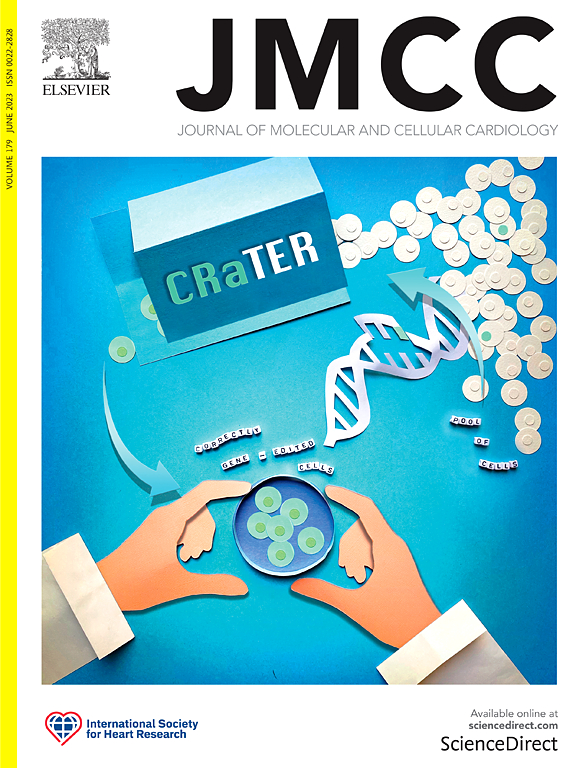光遗传线粒体预处理提高心肌细胞在应激下的存活率
IF 4.7
2区 医学
Q1 CARDIAC & CARDIOVASCULAR SYSTEMS
引用次数: 0
摘要
线粒体在预调节介导的细胞保护中起着核心作用,但线粒体膜电位在这一过程中的具体作用(ΔΨm)仍未完全了解。在这项研究中,我们采用了下一代线粒体靶向光遗传系统(mOpto)来诱导精确控制的(部分和短暂的)ΔΨm去极化,并研究其在增强心肌细胞抗应激能力中的作用。将表达mOpto的人AC16心肌细胞置于低强度LED照明下进行预处理,然后暴露于包括FCCP、H2O2或模拟缺血再灌注在内的应激源。与未预处理的对照组相比,mopto预处理的细胞表现出显著提高的活力,减弱ΔΨm去极化,减少活性氧(ROS)的产生。值得注意的是,这种细胞保护作用独立于典型ROS信号和线粒体atp敏感钾通道(mitoKATP)激活而发生。转录分析揭示了线粒体和代谢重编程的协调,包括参与脂质生物合成、线粒体质量控制、能量稳态和向线粒体融合转变的基因的上调。重要的是,mOpto预处理在人诱导多能干细胞来源的心肌细胞(hiPSC-CMs)中具有类似的细胞保护作用,强调了该方法的转化潜力。这些发现表明,mopto介导的瞬时ΔΨm去极化诱导了一种预处理效应,通过建立线粒体“记忆”和线粒体功能的动态重塑来增强心肌细胞的弹性。本文章由计算机程序翻译,如有差异,请以英文原文为准。

Optogenetic mitochondrial preconditioning enhances cardiomyocyte survival under stress
Mitochondria play a central role in preconditioning-mediated cytoprotection, yet the specific role of mitochondrial membrane potential (ΔΨm) in this process remains incompletely understood. In this study, we employed a next-generation, mitochondrial-targeted optogenetic system (mOpto) to induce precisely controlled (partial and transient) ΔΨm depolarization and investigate its role in enhancing cardiomyocyte resilience to stress. Human AC16 cardiomyocytes expressing mOpto were subjected to low-intensity LED illumination for preconditioning, followed by exposure to stressors including FCCP, H2O2, or simulated ischemia-reperfusion. mOpto-preconditioned cells exhibited significantly improved viability, attenuated ΔΨm depolarization, and reduced reactive oxygen species (ROS) production compared to non-preconditioned controls. Notably, this cytoprotective effect occurred independently of canonical ROS signaling and mitochondrial ATP-sensitive potassium channel (mitoKATP) activation. Transcriptional analysis revealed coordinated mitochondrial and metabolic reprogramming, including upregulation of genes involved in lipid biosynthesis, mitochondrial quality control, energy homeostasis, and a shift toward mitochondrial fusion. Importantly, mOpto preconditioning conferred similar cytoprotective effects in human induced pluripotent stem cell-derived cardiomyocytes (hiPSC-CMs), underscoring the translational potential of this approach. These findings demonstrate that mOpto-mediated transient ΔΨm depolarization induces a preconditioning effect that enhances cardiomyocyte resilience through the establishment of a mitochondrial “memory” and dynamic remodeling of mitochondrial function.
求助全文
通过发布文献求助,成功后即可免费获取论文全文。
去求助
来源期刊
CiteScore
10.70
自引率
0.00%
发文量
171
审稿时长
42 days
期刊介绍:
The Journal of Molecular and Cellular Cardiology publishes work advancing knowledge of the mechanisms responsible for both normal and diseased cardiovascular function. To this end papers are published in all relevant areas. These include (but are not limited to): structural biology; genetics; proteomics; morphology; stem cells; molecular biology; metabolism; biophysics; bioengineering; computational modeling and systems analysis; electrophysiology; pharmacology and physiology. Papers are encouraged with both basic and translational approaches. The journal is directed not only to basic scientists but also to clinical cardiologists who wish to follow the rapidly advancing frontiers of basic knowledge of the heart and circulation.

 求助内容:
求助内容: 应助结果提醒方式:
应助结果提醒方式:


